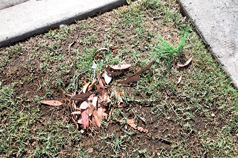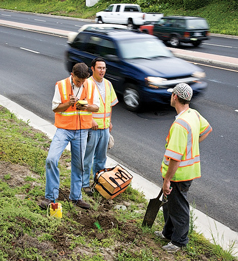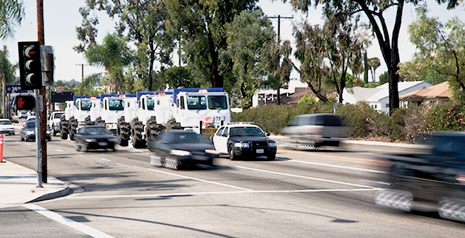Cable-free acquisition equipment and close interaction with the public helped Signal Hill Petroleum conduct a successful seismic program in California’s highly congested Long Beach area.
Dennis Freed, FairfieldNodal
A number of seismic data acquisition projects have been undertaken in large urban areas, such as Los Angeles and Long Beach, California, and Paris, France. Even so, the term urban jungle takes on a whole new meaning when acquiring seismic data in any municipality. In fact, urban areas share certain characteristics with natural jungles. Both environments have high-density populations—of people in cities and of (often protected) animal and plant species in the wild. Both are prone to daily and seasonal migration of these populations. Both are typically high-noise environments, with urban areas being especially prone to both coherent and random seismic noises. Both have many obstructions that make it difficult for seismic crews to move about easily, as well as restrictions on where, when and how many seismic instruments may be used. Finally, both are highly sensitive to any environmental impact and, in turn, harbor environmental (and, in the urban case, cultural) influences that can cause damage to the seismic equipment.
These complications created a challenge for Signal Hill Petroleum’s 2D seismic program in the municipalities of Signal Hill and Long Beach, California. To address these issues, the company used a new cable-free, continuous-recording land seismic system in conjunction with rigorous pre-planning that included close interaction with public officials and residents. These measures allowed the company to achieve what had been a prohibitively difficult task just a few years earlier: a smoothly operated, successful seismic data acquisition program in California’s highly congested Long Beach locale.
PREVIOUS ATTEMPT
The city of Signal Hill is a 2-sq-mi community of about 10,000 residents; it is completely surrounded by the city of Long Beach, which has more than 500,000 residents. About 80% of a producing oil field—Long Beach/Signal Hill (LB/SH) Field—is located in Signal Hill, with the remaining 20% in Long Beach. The operator, Signal Hill Petroleum Inc., estimates about 2 billion bbl of oil in place for the field. During the summer of 2009, the company conducted a 2D survey around the Signal Hill mound, located in Long Beach County south of Long Beach Airport.
Seismic surveys have been undertaken in this general area in the past. A 2D DFS-V prospect was acquired in 1984, and a 3D project was begun in 2006 using a remote seismic recorder (RSR) as the recording instrument. Both programs used vibroseis as the source. The 2006 prospect was terminated early on, primarily due to public concerns about the effects felt and heard from the seismic vibrators. During acquisition, residents became anxious when they experienced the physical impact caused by the vibrators’ sweeps, along with the noise generated by the vibrators as they waited for the receiver lines to complete troubleshooting.
Following this setback, Signal Hill Petroleum went back to the drawing board to redefine and calibrate both the sweep parameters and the operational plan that the company intended to use for the next seismic data acquisition attempt in this culturally and seismically sensitive area.
PLANNING THE SURVEY
To reduce the physical impact on residents, the vibrator sweep was completely redesigned. Signal Hill and its subsidiary Seismic Imaging Solutions Company (SISCO) initiated a research project to define a vibroseis sweep that both satisfied the public concerns and provided an acceptable source for the seismic survey. The signal-to-noise ratio of the various sweeps was analyzed, and a particle wave motion recorder was used to monitor any effect the vibrator sweeps might have on nearby structures.
Along with the recognized need to define the sweep, the company also realized the critical need to inform and educate the public, including civic officials, about what to expect during the acquisition phase of the seismic program. Several field trials were conducted for the various political and permitting authorities in the area to demonstrate the workings of the survey and what the public should expect to see, hear and feel from the seismic activity.
Signal Hill Petroleum obtained several permits to allow the system to be deployed. In addition to the “dig permits” acquired from the various utility commissions to deploy the recording equipment, the company obtained a “parade permit” to allow the vibrators to gain access to the public thoroughfares.
Once the political and permitting authorities were satisfied, a campaign was launched to inform the general public. Signal Hill and SISCO printed and distributed a pamphlet describing the actions the public should expect for the “Long Beach–Signal Hill Geophysical Survey.” This pamphlet was distributed to every residence and business along the route that the vibrator trucks would traverse.
The time and effort that Signal Hill and SISCO expended to obtain permits helped considerably to mitigate public concern to the point that the citizens appeared to harbor no ill sentiment or opposition to the survey.
ACQUISITION EQUIPMENT
Based on their previous experience in attempting to conduct a seismic survey in this area, Signal Hill and SISCO determined that a nodal survey utilizing a 100% cable-free, passive recording system would be necessary. The 2006 survey attempt had employed a minimal cable system to acquire the data, but there had still been significant concerns regarding this system.
Shortcomings of previous system. On the logistical front, the system used in 2006 was difficult to deploy, requiring the use of radio frequency repeaters to relay the commands from a central station to the various remote units, commanding them to acquire the seismic data. Occasionally, one or more of the remote units would miss the record command. This resulted in as many as six contiguous ground stations not recording a particular acquisition shot.
The remote units used in 2006 were also relatively large, having an antenna, an external battery and two spread cables each connected to as many as three geophone arrays of ground stations. Not surprisingly, they were something of a public curiosity. Some of the attention from the public was malicious in nature and resulted in damaged and non-operational equipment.
The layout crew worked diligently to smooth the cables, taping them to the sidewalks and asphalt where possible, and bunching the geophone strings together. Because the spread cables had fixed distances between their takeouts, the crews weren’t always able to utilize the optimal locations for placing the geophone arrays. Often, only two or three out of a possible six ground stations could be connected to a particular remote unit, resulting in underutilization of the available equipment.
Where the geophones could not be planted into soil, their spikes were removed and replaced with a base; sandbags were then placed over the geophones to maximize coupling to the sidewalk or asphalt. Unfortunately, none of these measures completely eliminated the “trip effect”—the concern that a pedestrian might fall and sustain an injury due to the deployment of the acquisition equipment.
New acquisition system. Given these limitations, the Signal Hill decision makers quickly agreed that they needed to contract Fairfield Industries (now FairfieldNodal) to provide its proprietary cable-free Z Land nodal seismic data acquisition system. The Sugar Land, Texas-based geophysical company leased the system to Signal Hill and provided technical assistance to SISCO in the use and deployment of the instrumentation.
The heart of the system is the acquisition node, which is a completely cable-free, continuous-recording Autonomous Recording Unit (ARU) node. The ARU nodes are self-contained individual recorders that can be buried beneath the ground’s surface so they cannot be seen, Fig. 1. In addition to the ARU nodes, Fairfield supplied a source coordinator to manage the vibrators and a data recording station. The latter was comprised of a data harvester to retrieve the data collected by the various ARU nodes and a data sorter to collate the retrieved seismic data into SEG-D field records.
 |
|
Fig. 1. A buried ARU node is shown, mostly obscured by leaves.
|
|
According to Signal Hill and SISCO, the cable-free acquisition system greatly enhanced the acquisition phase of the prospect. They were able to completely eradicate the “trip effect” and conceal the ARU nodes from view, thereby avoiding the public’s curiosity and any related malicious activities. Since there are no spread cables, the ARU nodes could be deployed in soil or dirt in any area of opportunity; none were placed on a sidewalk or on asphalt.
Because the ARU nodes record seismic data continuously, there was never any need to troubleshoot the receivers. Therefore, the vibrators were never delayed at any vibrator point (VP) waiting for the recorder to be readied for operation.
“The biggest impact of this system is that, with no cables, there’s no troubleshooting of the equipment,” said Hilario Camacho, vice president of earth sciences and exploration at Signal Hill Petroleum. “You just lay out the nodes and get the sources going, and we got the survey done in a short time.”
SHOOTING THE PROSPECT
Seismic Imaging Solutions operated the LB/SH 2D seismic acquisition project—referred to as Phase I—using the cable-free acquisition system for the data recording. The entire prospect was shot using vibroseis. Four IVI Hemi-60 vibrators provided the source energy.
The program consisted of four 2D lines. Two of the 2D lines were oriented north–south, with one on each side of the Signal Hill mound. The other 2D lines were oriented east–west; both lay north of the Signal Hill mound. The lines were deployed along the sides of city streets, with one line bisecting Long Beach Airport taxiways and runways. Three lines crossed Interstate 405.
Each 2D line was deployed and shot individually. The receivers were placed at points of opportunity parallel to the street (Fig. 2), and the sources generally moved down the middle of the street. In areas having open fields, the receivers were placed at equal intervals. In residential and business districts, while the exact location of each ARU node was known, they were placed at less uniform intervals out of necessity. Areas of greenery or soil that were present in esplanades or alongside sidewalks were utilized, along with any other available locations where the ARU node could be coupled directly to the earth.
 |
|
Fig. 2. An ARU node is deployed alongside a busy thoroughfare.
|
|
The Phase I program entailed 678 receiver points and 465 source points. On three of the lines, the receiver and source intervals were equal at 80 ft each; on one line, the receiver interval was 55 ft and the source interval was 110 feet. All four lines were shot using a point-source/point-receiver methodology.
The final product for the sweep definition was 30 sweeps per VP, an 8-sec. linear sweep of 5 Hz to 72 Hz, a 1.8-sec. taper in, a 0.3-sec. taper out, and a 6-sec. listen time. Drive levels varied from 30% to 70% depending upon location. Each VP was acquired within 420 sec., or 7 min. There was no overhead between sweeps, and the only overhead VP-to-VP was vibrator move-up time.
To reduce the impact of the survey, the hours of operation were restricted for the populated areas. In these areas, the sources could only be activated between the hours of 9 a.m. and 3 p.m. local time, Monday through Friday. It was determined that this schedule would be the least disruptive to the local populace. At other times (e.g., after normal workday hours when there were fewer people present), operations were moved to other areas, such as the airport and the business and warehouse districts.
During the survey, the vibrator trucks were accompanied by two police cars, one in the front and one in the rear, to maintain traffic control, Fig. 3. At the rear of the vibrator fleet, a truck-mounted arrow sign warned oncoming traffic of the presence of the vibrators. As the vibrators traversed the streets, advance personnel were in position ahead of the fleet to inform people in residences and businesses of the upcoming action. This precaution ensured that no residents were surprised by the vibrator activity. A frequent comment expressed by the onlookers during this activity was, “Is that all there is to it?”
 |
|
Fig. 3. Vibrator trucks proceed along Cherry Avenue with a police escort.
|
|
To assist in determining the possible effects that their activity might have on nearby structures, Signal Hill hired Ameridian Technologies Inc., a seismic technologies and litigation support company. Ameridian technicians monitored the activity and particle motion for every VP in the survey.
Despite the constraints placed upon the survey, work proceeded rapidly. The first VP was acquired on the morning of July 20, 2009, and the last VP of the last line was acquired 11 days later on the afternoon of July 31.
At present, the preliminary data from the survey appear to be of very high quality. In fact, one of the lines revealed a shallow bright spot near a well being drilled, which had not been tested by the well. This bright spot will likely be tested by another well at a different location.
PLANNED FUTURE PROSPECT
Signal Hill is now involved in the planning stage for a 3D survey of the area.
“Absent the seismic data, we’ve done everything we can to understand the very complex subsurface picture,” said Dave Slater, executive vice president and chief operating officer at Signal Hill Petroleum. “That’s why we’re so motivated to pursue the 3D data acquisition.”
For this project, the company plans to take advantage of the cable-free acquisition system’s flexible capabilities to deploy the ARU nodes at a 45° angle relative to the source lines in areas of opportunity throughout the survey area. The source lines will utilize the north–south and east–west streets. It is believed that the random nature of the ARU node placement and the 45° angle relative to the source lines will lead to a very rich offset and azimuth distribution. This planned 3D survey is scheduled to be implemented in early to mid-2010. 
|
THE AUTHOR
|
 |
Dennis Freed is the Technical Marketing Manager for FairfieldNodal Systems Division in Sugar Land, Texas. Mr. Freed has been with Fairfield for 10 years. He previously worked in the seismic industry for GeoSource, Halliburton, OpSeis and Syntron. He has more than 35 years’ experience in remote sensing engineering, and has also worked in the fields of aerospace, medical, nuclear and seismic instrumentation design and development. He holds degrees in electronics technology and computer technology. He can be reached at dfreed@FairfieldNodal.com.
|
|
| |
|
|






